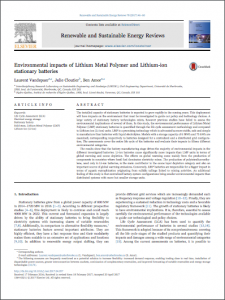Full Title: Environmental impacts of Lithium Metal Polymer and Lithium-ion stationary batteries
Author(s): Laurent Vandepaer, Julie Cloutier, Ben Amor
Publisher(s): Renewable and Sustainable Energy Reviews
Publication Date: May 1, 2017
Full Text: Download Resource
Description (excerpt):
The installed capacity of stationary batteries is expected to grow rapidly in the coming years. This deployment will have impacts on the environment that must be investigated to guide our policy and technology choices. A large variety of stationary battery technologies exists, however previous studies have failed to assess the environmental implications of several of them. In this study, the environmental performance of Lithium Metal Polymer (LMP) stationary batteries is quantified through the life cycle assessment methodology and compared to Lithium-ion (Li-ion) units. LMP is a promising technology which is advocated as more stable, safe and simple to manufacture than batteries with liquid electrolytes. Models with a storage capacity of 6 MWh and 75 kWh are examined, corresponding respectively to batteries designed for a centralized and a distributed grid configuration. The assessments cover the entire life cycle of the batteries and evaluate their impacts in fifteen different environmental categories.
The results show that the battery manufacturing stage drives the majority of environmental impacts in the different investigated batteries. Li-ion batteries cause significantly more impacts than LMP units in terms of global warming and ozone depletion. The effects on global warming come mainly from the production of components in countries where fossil fuel dominates electricity mixes. The production of polytetrafluoroethylene, used only in Li-ion batteries, is the main contributor to the ozone layer depletion category and also an important source of global warming emissions. Conversely, LMP batteries are responsible for a bigger impact in terms of aquatic eutrophication originating from sulfidic tailings linked to mining activities. An additional finding of this study is that centralized battery system configurations bring smaller environmental impacts than distributed systems with more but smaller storage units.
